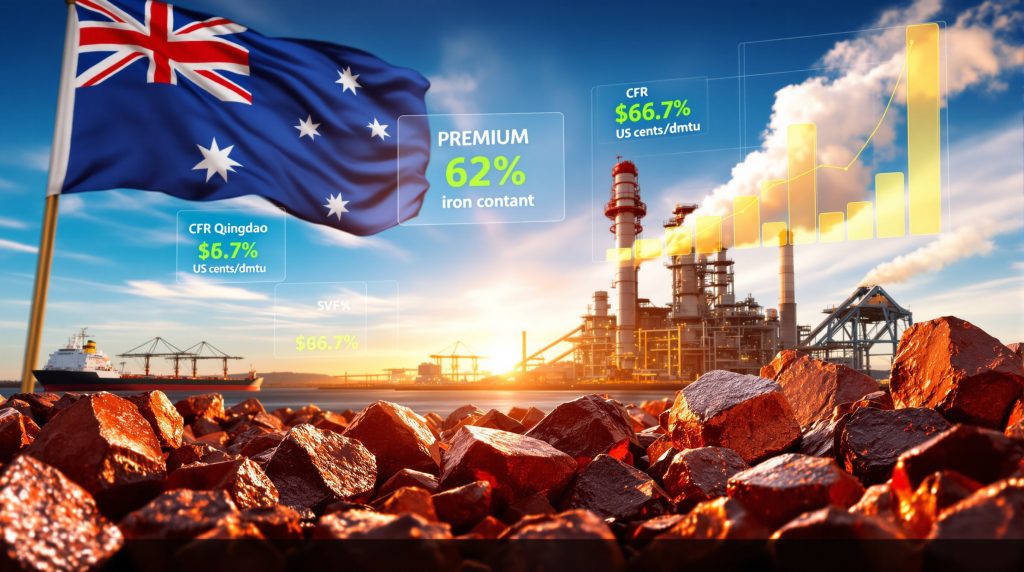Understanding Premium Pricing Fundamentals
The iron ore 62% Australia-origin lump ore premium represents a critical pricing mechanism in global commodity markets that reflects the superior value proposition of high-grade Australian iron ore lump materials. This premium pricing structure operates independently from standard iron ore price trends, creating a distinct market segment for steel mills seeking enhanced operational efficiency.
Premium pricing in iron ore markets functions as a quality-based differential that acknowledges the varying characteristics and performance benefits of different ore types. While standard iron ore fines serve as the baseline commodity, lump ore commands additional value due to its direct-use capabilities in blast furnace operations.
The market establishes these premiums through sophisticated pricing methodologies that track spot market conditions across major trading hubs. Quality specifications play a fundamental role in determining market value, with precise chemical composition requirements driving price differentials between various ore grades.
Physical Properties That Drive Premium Values
Australian lump ore demonstrates superior blast furnace performance characteristics that justify premium pricing structures. The material's granular composition allows for direct charging into blast furnaces without requiring preliminary processing steps, eliminating costly sintering operations that fines-based materials necessitate.
Direct charging capabilities represent a significant operational advantage for steel producers. Unlike iron ore fines that must undergo sintering to create suitable blast furnace feed, lump ore maintains optimal size distribution and structural integrity throughout the steelmaking process.
Moisture content advantages provide additional handling benefits that contribute to premium valuations. Australian lump ore typically maintains lower moisture levels compared to alternative sources, reducing transportation costs and improving storage efficiency for steel mill operators.
Pricing Methodology and Market Benchmarks
The iron ore 62% Australia-origin lump ore premium calculation follows established market benchmarks centred on CFR Qingdao spot market reference points. According to Fastmarkets' launch of iron ore 62% Australia origin lump ore premium methodology, launched on October 21, 2025, this premium tracks the spot price differential between 60-63% Fe iron ore lump and 61% Fe iron ore fines in the Chinese import market.
Key Pricing Parameters:
• Assessment timing: Daily at 6:30 PM Singapore time
• Unit measurement: US cents per dry metric tonne unit (dmtu)
• Methodology: Quantity-weighted model with outlier screening
• Market focus: CFR Qingdao, normalised for Chinese mainland seaports
The pricing framework employs rigorous quality specifications to ensure consistency across transactions. Furthermore, the methodology screens outliers and applies quantity-weighted calculations to provide robust market representation for industry participants.
Quality Specifications That Define Market Standards
Market standards for the iron ore 62% Australia-origin lump ore premium establish precise chemical composition parameters that determine eligibility for premium pricing. The specifications create clear quality thresholds that reflect the superior characteristics driving market demand.
Chemical Composition Requirements:
| Component | Base Level | Maximum Limit |
|---|---|---|
| Iron Content (Fe) | 62% | 61-65% range |
| Silica | 3.8% | 5% |
| Alumina | 1.7% | 2% |
| Phosphorus | 0.10% | 0.10% |
| Sulfur | 0.02% | 0.04% |
| Moisture | 4% | 6.5% |
Physical characteristics include granularity specifications with maximum 13.5% below 6.3mm and maximum 25% above 31.5mm. These parameters ensure optimal blast furnace performance while maintaining handling efficiency throughout the supply chain.
Trading Terms and Contract Specifications
Standard trading terms for premium lump ore transactions establish minimum quantity requirements of 30,000 tonnes per shipment. This threshold ensures economic viability for both producers and consumers while maintaining market liquidity.
Delivery timeframes operate within 2-8 weeks from contract execution, providing flexibility for supply chain planning while ensuring reasonable market responsiveness. Payment terms default to Letters of Credit on sight, with other arrangements normalised to baseline conditions.
Port normalisation factors account for delivery variations across Chinese mainland seaports, ensuring price consistency regardless of specific discharge location. Consequently, this standardisation simplifies contract negotiations and reduces geographical pricing disparities.
Supply-Side Market Dynamics
Australian production capacity demonstrates significant seasonal variations that influence premium pricing fluctuations. Mining operations across Western Australia's Pilbara region experience weather-related disruptions during cyclone season, typically affecting January through March production schedules.
Mining companies increasingly focus strategic planning on lump yield optimisation through modern mine planning techniques to capitalise on premium pricing opportunities. Production decisions balance between maximising overall output volumes and enhancing lump ore recovery rates through selective mining and processing techniques.
Infrastructure constraints affecting lump ore availability create supply bottlenecks that support premium valuations. Port capacity limitations and rail transport scheduling can restrict lump ore shipments even when mine production remains stable.
Demand-Side Pressures from Steel Industry
Chinese steel mill preferences for direct charging materials continue driving robust demand for premium lump ore. Environmental regulations increasingly favour processing methods that reduce emissions, making lump ore's direct-use capabilities more attractive to steel producers.
Environmental Regulation Impacts:
• Sintering plant restrictions in major industrial regions
• Air quality improvement initiatives affecting processing choices
• Carbon reduction targets influencing steelmaking methods
• Energy efficiency requirements promoting direct charging
Blast furnace efficiency requirements in global steelmaking operations support sustained demand for high-quality lump materials. In addition, steel mills recognise operational cost benefits from improved furnace productivity and reduced processing complexity.
Competitive Positioning Against Alternative Sources
Brazilian lump ore serves as the primary competitive alternative to Australian material, though quality differences and transportation considerations affect relative market positioning. Australia's iron ore advantages include geographical proximity to Asian markets, reducing shipping costs and delivery timeframes.
Transportation cost advantages for Australia-origin material become particularly significant during periods of elevated freight rates. Shorter shipping routes to major Asian steel producing regions provide cost efficiency that supports premium pricing sustainability.
Long-term supply contract influences on spot pricing create market dynamics where contracted volumes may trade at different levels than spot transactions. These contractual arrangements provide price stability for producers while influencing overall market liquidity.
Operational Cost Benefits in Steel Production
Steel mills justify premium payments for Australian lump ore through quantifiable operational cost benefits that exceed the additional material costs. Energy savings from eliminating sintering processes represent the most significant economic advantage, reducing fuel consumption and processing time requirements.
Environmental compliance costs decrease substantially when steel mills utilise direct charging lump ore versus fines-based materials. Sintering operations generate higher emissions levels, requiring additional pollution control investments and operational monitoring.
Improved blast furnace productivity metrics demonstrate measurable performance enhancements from high-quality lump ore utilisation. Furnace campaigns operate longer between maintenance shutdowns, while daily production rates increase due to optimal material flow characteristics.
Cost-Benefit Analysis:
| Operational Factor | Lump Ore Advantages | Fines Processing Requirements |
|---|---|---|
| Energy Consumption | Direct blast furnace charging | Sintering plant operations |
| Processing Time | Immediate use capability | Additional preparation steps |
| Environmental Impact | Lower emissions profile | Higher CO2 from sintering |
| Handling Efficiency | Reduced dust generation | Dust management systems |
| Maintenance Costs | Extended campaign life | Frequent sintering equipment service |
Quality Consistency and Reliability Factors
Predictable chemical composition profiles from major Australian producers enable steel mills to optimise their operational parameters with confidence. Consistent ore quality reduces the need for frequent blast furnace adjustments and improves overall process stability.
Lower impurity levels compared to alternative sources minimise downstream processing challenges and improve steel quality outcomes. Australian lump ore typically demonstrates superior consistency in phosphorus and sulfur content, critical factors for steel grade specifications.
Established supply chain reliability from major Australian producers provides operational security for steel mill procurement strategies. However, long-term mining operations and stable political environments reduce supply disruption risks compared to emerging market alternatives.
Production Strategy Optimisation
Major Australian iron ore producers implement sophisticated mine planning focused on maximising lump yield ratios to capitalise on premium pricing opportunities. Selective mining techniques and geological modelling optimise ore body extraction to enhance lump ore recovery rates.
Processing plant configurations specifically target lump recovery through screening and handling systems designed to minimise degradation during processing stages. Investment in crushing and sizing equipment balances production efficiency with lump ore preservation.
Quality control systems ensure premium specifications through continuous monitoring and testing protocols. Advanced analytical equipment and automated sampling systems maintain consistency across production batches while meeting stringent market requirements.
Market Positioning and Contract Strategies
Long-term agreements with premium pricing mechanisms provide revenue stability while maintaining exposure to spot market opportunities. Producers structure contracts with pricing formulas that capture premium fluctuations while ensuring baseline profitability.
Spot market participation during favourable conditions allows producers to optimise revenue generation when supply-demand imbalances support elevated premiums. Strategic inventory management enables tactical market timing for premium sales.
Geographic diversification of customer base reduces market concentration risks while maximising pricing opportunities across different regions. Furthermore, producers maintain relationships with steel mills in multiple countries to optimise revenue and reduce dependency on single market conditions.
Investment in Infrastructure and Technology
Port facilities optimised for lump ore handling incorporate specialised equipment and storage systems designed to minimise material degradation. Investment in conveyor systems, stockyard management, and ship loading technology preserves lump ore integrity throughout the export process.
Transportation systems minimising degradation include specialised rail car designs and handling protocols that reduce material breakdown during transit from mine to port. Dust suppression and material handling improvements maintain product quality standards.
Quality assurance technologies for consistent specifications employ automated sampling, real-time analysis, and statistical process control to ensure premium grade requirements. Investment in laboratory facilities and testing equipment supports quality certification processes.
Environmental Policy Impacts on Steel Industry
Chinese environmental policies significantly influence demand patterns for the iron ore 62% Australia-origin lump ore premium through regulations targeting sintering operations. Restrictions on sintering plant operations in major industrial regions create strong demand drivers for direct charging lump materials.
Air quality improvement initiatives affect steelmaking process choices by penalising high-emission production methods. Consequently, steel mills increasingly favour lump ore utilisation to reduce their environmental compliance burden and operational restrictions.
Carbon neutrality goals influencing steelmaking methods create long-term structural demand for cleaner production processes. Lump ore's reduced processing requirements align with emission reduction objectives across the Chinese steel industry.
Regional Demand Variations Across China
Coastal mill preferences for imported lump ore reflect both logistical advantages and environmental considerations. Seaboard steel facilities demonstrate higher willingness to pay premiums for quality materials that enhance operational efficiency.
Regional Demand Patterns:
• Eastern coastal regions: Highest premium acceptance due to environmental pressures
• Northern industrial zones: Seasonal demand variations from heating restrictions
• Southern manufacturing areas: Consistent demand from automotive and construction sectors
• Inland facilities: Price sensitivity due to additional transportation costs
Inland facility logistics considerations influence premium pricing acceptance, as transportation costs from ports reduce economic benefits. Steel mills in interior regions demonstrate greater price sensitivity for premium materials.
Seasonal demand patterns affecting premium levels correlate with environmental restriction enforcement periods. Winter heating seasons and pollution control campaigns create demand spikes for cleaner processing materials.
Alternative Processing Technology Adoption
Direct reduction iron (DRI) facility development in China represents a long-term shift toward hydrogen-based steelmaking technologies. These facilities require high-quality iron ore inputs, potentially increasing demand for premium Australian lump materials.
Electric arc furnace expansion plans across the Chinese steel industry may reduce overall iron ore demand insights while maintaining premium material requirements for specialised applications. Quality specifications become more critical in technologically advanced steelmaking processes.
Hydrogen-based steelmaking pilot projects demonstrate increasing focus on cleaner production technologies that may favour high-grade iron ore inputs. These emerging technologies could create new demand categories for premium Australian materials.
Long-Term Trend Analysis
Premium evolution over the past decade demonstrates cyclical patterns influenced by global steel production cycles and supply-demand imbalances. Historical analysis reveals premium ranges typically fluctuating between supply-constrained periods and demand-driven expansions.
Correlation with global steel production cycles shows premium levels responding to capacity utilisation rates across major steel producing regions. Peak production periods generally support elevated premiums through increased competition for quality materials.
Major supply disruption impacts on pricing include weather events, labour disputes, and infrastructure failures that temporarily restrict Australian lump ore availability. However, these disruptions historically create significant premium spikes lasting several weeks to months.
Seasonal and Cyclical Variations
Weather-related supply interruptions primarily occur during Australia's cyclone season, affecting Pilbara region operations from December through March. These seasonal patterns create predictable premium elevation periods as supply availability decreases.
Seasonal Impact Timeline:
• Q1: Cyclone season disruptions supporting premium levels
• Q2: Production normalisation moderating premiums
• Q3: Maintenance shutdown season creating supply tightness
• Q4: Peak production period generally pressuring premiums
Chinese New Year demand patterns create unique market dynamics as steel mills build inventory ahead of extended holiday shutdowns. Pre-holiday stockpiling often supports premium levels during January-February periods.
Maintenance shutdown scheduling effects influence premium timing as coordinated maintenance across multiple producers can create temporary supply constraints. Strategic maintenance timing by major producers affects market dynamics.
According to Trading Economics iron ore data, market participants observe that the Australia-origin lump premium demonstrates resilience during periods of global economic uncertainty, reflecting the strategic importance of quality raw materials in steel production cost optimisation and environmental compliance strategies.
Technology Disruption Potential
Alternative ironmaking processes development poses long-term risks to traditional blast furnace-based demand for lump ore. Direct reduction technologies and hydrogen-based steelmaking may alter quality requirements and volume demands for premium materials.
Pellet feed quality improvements could provide competitive alternatives to lump ore for direct charging applications. Advances in pelletising technology may narrow the performance gap between pellets and lump materials.
Scrap steel availability increases in mature economies reduce overall iron ore demand intensity, though quality requirements for remaining ore consumption may become more stringent. Higher scrap utilisation rates affect total iron ore market dynamics.
Geopolitical and Trade Considerations
Australia-China trade relationship dynamics create ongoing uncertainty for premium sustainability despite strong commercial fundamentals. Political tensions may influence policy decisions affecting bilateral trade flows, particularly considering US-China trade impacts on global commodity markets.
Alternative supplier development in other regions, including Africa and South America, could provide competitive pressure on Australian premium positioning. New mine developments with similar quality profiles may challenge market share.
Currency fluctuation impacts on pricing affect relative competitiveness of Australian materials versus alternative sources. Exchange rate movements between Australian dollar, US dollar, and Chinese yuan influence economic relationships.
Environmental and Regulatory Changes
Carbon pricing mechanisms in steel production may enhance the value proposition for lump ore through reduced processing requirements. Environmental costs increasingly factor into raw material selection decisions.
Mine permitting and expansion restrictions could limit Australian supply growth potential, supporting premium levels through supply constraint mechanisms. Regulatory approval timeframes affect new capacity development.
Transportation emission regulations may influence relative cost competitiveness between different supply sources. Shipping emission requirements could affect freight cost calculations and source selection decisions.
Steel Mill Procurement Strategies
Raw material sourcing optimisation models increasingly incorporate premium fluctuation analysis to determine optimal purchasing timing and contract structures. Steel mills develop sophisticated algorithms balancing spot market opportunities with supply security requirements.
Inventory management based on premium forecasts enables steel mills to optimise working capital while ensuring adequate raw material availability. Strategic stockpiling during low premium periods provides cost advantages during market tightness.
Contract negotiation timing decisions reflect expected premium trends and market conditions. Mills structure procurement agreements to capture favourable pricing periods while maintaining operational flexibility.
Mining Company Revenue Planning
Production mix optimisation for maximum profitability drives strategic decisions about mining sequences and processing configurations. Companies balance volume production with quality enhancement to maximise revenue per tonne.
Capital allocation decisions for lump-focused operations require long-term premium sustainability analysis. Investment decisions consider both current market conditions and projected demand evolution.
Market entry timing for new projects depends on premium level expectations and competitive positioning relative to existing suppliers. Project economics incorporate premium volatility analysis for financial modelling.
Trading and Financial Market Applications
Commodity derivative pricing models increasingly incorporate premium elements to provide hedging opportunities for market participants. Financial instruments may develop around premium volatility to manage price risk.
Risk management strategies for physical traders include premium spread analysis and arbitrage opportunities between different quality grades. Trading strategies evolve to capture premium fluctuation profits.
Investment analysis for resource sector exposure considers premium sustainability as a key value driver for Australian iron ore producers. Consequently, equity valuations reflect premium earning potential and market positioning strength.
Supply-Side Development Projections
New Australian lump ore projects in development pipeline include expansions at existing operations and greenfield developments targeting premium market segments. Project announcements indicate continued industry confidence in premium demand sustainability.
Existing mine expansion plans and capacity additions focus on lump ore recovery optimisation rather than simple volume increases. Producers prioritise value over volume in expansion planning decisions.
Technology improvements in lump ore recovery rates through advanced processing techniques may increase supply availability while maintaining quality standards. Innovation in mining and processing technology supports production efficiency.
Demand Evolution in Global Steel Industry
Emerging market steel consumption growth creates new demand sources for premium iron ore materials as developing economies invest in efficient steelmaking technologies. Quality requirements may increase as these markets mature.
Global Steel Demand Projections:
• Asian emerging markets: Continued growth with quality focus
• Developed economies: Stable demand with efficiency emphasis
• Middle East and Africa: Growing industrial development
• Latin America: Infrastructure-driven demand increases
Developed market steel intensity trends show stabilising consumption patterns with emphasis on quality and efficiency rather than volume growth. Mature markets prioritise environmental performance and cost optimisation.
Alternative materials competition in construction sectors may reduce overall steel demand growth rates, though specialised applications may maintain premium material requirements. Market evolution reflects technological advancement and sustainability priorities.
Frequently Asked Questions
What makes Australian lump ore command a premium over other origins?
Australian lump ore demonstrates superior quality consistency with lower impurity levels compared to alternative sources. The material offers predictable chemical composition profiles and reliable supply chain performance that justify premium pricing for steel mill operators seeking operational optimisation.
How often does the premium pricing change?
The iron ore 62% Australia-origin lump ore premium receives daily assessment at 6:30 PM Singapore time, reflecting real-time market conditions. This frequent pricing reflects trading activity across the CFR Qingdao spot market according to established methodology.
Can smaller steel mills access Australia-origin lump ore?
Minimum quantity requirements of 30,000 tonnes per shipment may challenge smaller steel mill operations. However, trading companies often aggregate smaller requirements from multiple consumers to meet specification thresholds, enabling broader market access for premium materials.
What factors most influence premium fluctuations?
Supply disruptions from weather events, environmental regulations affecting steel production methods, and seasonal demand patterns represent the primary drivers of premium volatility. Chinese environmental policies and Australian production capacity utilisation significantly impact pricing dynamics.
How do steel mills justify paying premium prices?
Steel mills justify premium payments through operational cost benefits including energy savings from eliminated sintering processes, improved blast furnace productivity, and reduced environmental compliance costs. These operational advantages typically exceed the additional material costs for quality-focused operations.
This analysis incorporates pricing methodology and specifications from established market assessments. Market participants should verify current pricing and specification details through official publications and recognised industry sources.
Looking to Capitalise on Iron Ore Market Opportunities?
Discovery Alert's proprietary Discovery IQ model instantly identifies significant ASX mineral discoveries, including iron ore developments that could benefit from premium pricing trends like those outlined above. Explore how major mineral discoveries have delivered substantial returns to early investors, and begin your 30-day free trial today to gain immediate access to actionable market intelligence.




